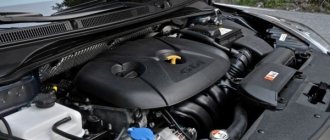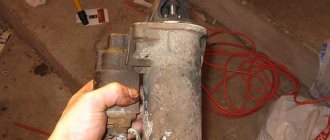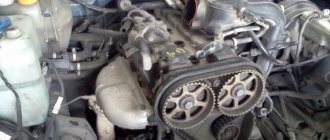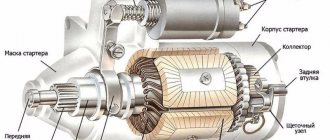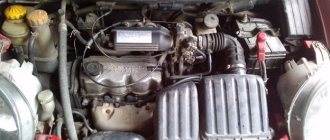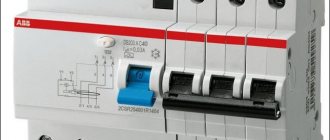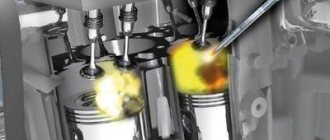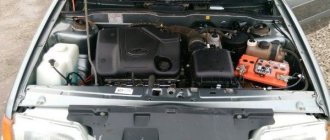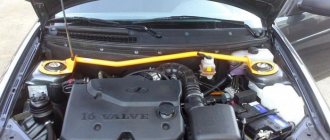Starter device
First, let's look at how a starter works:
- when the driver turns the key to the extreme right position, current flows to the starter winding;
- the crankshaft flywheel engages with the overrunning clutch gear;
- The crankshaft, rotating, transmits torque to the pistons, the combustible mixture begins to enter the cylinders and ignite through ignition;
- at approximately 100 revolutions the clutch and flywheel are separated;
- after the circuit is opened, the key goes to the middle position, the starter shaft does not rotate.
Schematic structure of the system:
Starter device:
If the starter hums but does not turn the engine, this behavior indicates a wide range of different malfunctions. The peculiarity of the situation when the engine does not start is that there are certain difficulties in localizing the problem: it may lie in the fuel pump that does not turn on after turning the key, in the starter’s refusal to turn the crankshaft, etc. But in the general case, a common phenomenon is when the starter “turns” and turns out to be is able to rotate the crankshaft, but the engine refuses to start.
What to check first
Naturally, every driver, getting behind the wheel again, expects that after the very first revolutions of the starter shaft, the engine will begin to operate smoothly, stably and cleanly. But sometimes the car owner’s hopes are not justified: the starter turns, but the car does not start. That is, the starter does not turn the engine, which is its functional responsibility. Of course, this is not a second-rate problem, because if the starter turns poorly or if it refuses to do so at all, then the car is unlikely to move even a meter. Therefore, if such a difficulty arises, the first thing to do is to check the condition of the most basic automotive components, the failure of which could cause problems. You can do this on your own or entrust this difficult task to specialists. If a car enthusiast is confident in his knowledge and has decided to independently look for the reasons why the starter does not turn, then I would advise you to first check the following car devices:
- Candles - they are the object of creating sparks that ignite the fuel-air mixture in the engine cylinders. Naturally, they must be in good condition and not have accumulated carbon deposits on them, because this is the reason for the uneven operation of the engine.
- Fuel filters are an equally important element in a car, designed to filter out rust and dust particles, at the same time preventing them from entering the entire fuel system of the engine. It is quite possible that they stopped filtering, which is why they failed, and this provoked the problem that the starter turns, but does not start.
- The battery is perhaps the most common cause of problems in everything, because as soon as the charge of this unit drops to zero, the car will stand still as if rooted to the spot. Therefore, checking the charge level and ensuring that it is always in optimal condition is simply necessary.
- Terminals - they are included in the list of battery components, but they should be highlighted as a separate item, since these particles, despite their small size, play a significant role in the overall operation of the car. I want to draw your attention to the fact that the driver should always be sure that the terminals on the battery are in good condition, that they have not oxidized, and then the problem that the starter turns, but does not engage, is unlikely to arise again. or it doesn't turn at all.
- The throttle valve is another important element of the car, which is a mechanical regulator of the flow area of the channel, which is designed to regulate the level of the medium that flows in this channel. We are talking about gas or any kind of liquid. It is recommended to keep this device clean so as not to face the problem of the car engine failing to work.
Starter malfunction
Before you do an in-depth check of the components, you should make sure that the starter itself is in order. It should work without any extraneous sounds - clicks, hums, etc. The starter electric motor normally operates smoothly, without failures or any omissions. The malfunction is determined by ear, and if the starter clicks but does not turn the engine, the cause is most likely in the starter itself.
Of course, if after turning the key nothing happens at all, this unit also needs to be checked for serviceability. So, the absence of a click clearly indicates a breakdown of the solenoid relay.
If the starter rotates the shaft normally, but the engine still refuses to start, you should check:
- fuel system;
- ignition;
- state of sensors of the electronic engine control system;
- flywheel ring teeth or clutch gears - they may be worn out. This is a common reason why the starter turns but does not turn the engine. The malfunction may also be accompanied by the grinding sound of worn teeth.
These problems can manifest themselves in both “cold” and “hot” conditions. Another reason why the starter does not turn on a hot engine is a malfunction of the power unit: for example, the crankshaft liner is worn, which is pinched when heated, or there is an axial displacement of the shaft. The starter does not turn well on a hot engine if the piston group is faulty, the battery is discharged, the ignition is incorrectly configured and the starter elements are worn out.
It is also possible that the crankshaft cranks too slowly when trying to start. There may be several reasons why the starter turns the engine slowly:
- poorly charged battery that does not produce sufficient current;
- faulty solenoid relay;
- wiring problems;
- The oil is too thick.
The car starts and stalls
A car's engine is its main part, its heart. And if it doesn’t work, the car, unfortunately, won’t drive.
The reasons why the engine starts but immediately stalls are as follows:
- Starter. The car does not start due to its malfunction. You can solve the problem by removing this spare part and checking all its parts. Perhaps the contacts have come loose or some elements of the starter have worn out.
- Car won't start? The carburetor may be acting up. This can happen because the drive rod has come out of alignment, the fitting falls out of the housing, the pump nozzle is clogged, or there is no fuel supply to the carburetor.
- Problems with the fuel pump. The intake filter into the gas tank is clogged.
- Failures in the ignition system or problems with the distributor.
Thus, problems associated with starting the engine may lie in the carburetor or in the car’s ignition system. The main reason is loose fitting of parts, contamination, and leaky connections.
Failures outside the starter
Most engine failures with a working starter are due to the fact that there is either “nothing to burn” or “nothing to ignite”. Let's take a closer look at them.
Fuel system
It consists of several elements that should be checked step by step:
- fuel pump (electric or, in some car models, mechanical driven by the engine);
- fuel supply system - carburetor or injector;
- fuel line;
- filters that clean the fuel passing through the highways.
Another possible reason is a disruption in the fuel supply due to the formation of suction in the system; it should be found and eliminated.
An important note concerns diesel engines: if the owner has chosen the wrong diesel fuel in the winter, in the cold it thickens (waxes), and the fuel supply system units simply cannot pump the fuel to deliver it to the cylinders.
Owners of cars with injection engines know that immediately after turning the key you can hear the fuel pump turn on for one or two seconds. Its job is to supply fuel to the system, and if the pump is faulty, the engine will not start. The sound of its operation is a characteristic hum, and when it is not heard, then most likely the problem is in the fuel pump or its power circuits. You need to check the correctness:
- the electric fuel pump itself;
- relay;
- fuse;
- power wires going to the node.
Injection pump VAZ 2109:
Interesting: for injection cars, you should check whether there is fuel in the fuel rail. It has a special control valve, when pressed, gasoline should begin to flow. This will indicate that fuel is present in the ramp and is supplied to the injectors.
If the car is carburetor, then its pump is most likely driven by transmitting torque from the camshaft. To carry out the check, you need to remove the hose going to the carburetor inlet fitting; in addition, the hose can be removed from the pump outlet. After this, use the manual pump lever (located on the pump) to pump up some fuel. If the unit is in order, gasoline will leak out.
Note: the author has repeatedly had to deal with the situation of a fuel pump failure, when the car was driving for quite a long time with an almost empty tank, without adding fuel. The fact is that gasoline at domestic gas stations is not always of high quality; it contains impurities that settle at the bottom of the tank. When the filling of the fuel tank drops, the pump begins to “scoop up” dirty gasoline/diesel with sediment from the bottom, which clogs the pump mechanism, filters, fuel injectors, leading to malfunctions, engine tripping, and a complete inability to start it.
There are often situations when fuel filters become clogged, then the liquid can no longer pass through them normally, and the starter “turns” idle. Filters should be checked and cleaned/replaced if necessary.
Diagnostics
- If the fuel pressure regulator is not working well, it usually needs to be replaced. To verify that it is faulty, you need to unscrew the fuel return hose and then turn on the ignition. If gasoline comes out of this hose under high pressure, the regulator will not work. To eliminate a fault in the path, it is enough to plug one end of it, or press down the return pipe, thereby reducing its cross-section. Having carried out such work, you can easily get to the repair site.
- If the spark is not supplied to the cylinders properly, interruptions in engine operation occur. To verify that this unit is faulty, you must have a special wrench on hand for unscrewing the spark plugs. Having unscrewed the spark plugs, you need to connect them to the tips of the high-voltage wires and turn the starter several times. If the spark goes to the side or its strength is not enough, this unit needs to be replaced. As a rule, a car with such a breakdown can get to the repair site on its own
Attention!
Follow safety regulations when carrying out such work. The high-voltage part of the car is very dangerous to life and health. If the valve timing marks are set incorrectly, the engine runs with significant interruptions with characteristic popping noises.
This malfunction cannot be eliminated without the proper equipment and tools. If this malfunction occurs to you on the road, do not try to fix it yourself. Tow the car to the nearest car service center and only carry out repairs there.
If the damper that regulates the air flow is faulty, there are several ways to identify this breakdown and also fix it. Unscrew the air supply pipe and inspect the throttle valve for integrity.
When the engine is turned off, its position should be in the closed state. If this does not happen, this unit must be cleaned and then adapted using computer equipment. As practice shows, this malfunction appears gradually and cannot just happen on the road. Accordingly, such repairs must be done at a specialized service station.
If the engine of your Logan starts and immediately stalls after a while, pay attention to the dashboard, namely, whether the immobilizer indicator lamp is illuminated. If this indicator light flashes, the immobilizer unit has lost communication with the key chip. You can continue driving only by using another spare key to replace the old one.
With the help of special equipment, the key used can be registered in the program of the immobilizer unit, but this is done on special equipment.
Tip: Carry a spare key with you if you go on a long journey.
- The operation of fuel injectors can only be checked at an equipped stand; accordingly, such repairs are carried out by specialists.
- If the fuel filter in your car is clogged, of course, this element must be replaced. In case this situation befalls you on the road and the engine stalls, there are some recommendations for detecting and eliminating this malfunction.
- Open the hood, then remove the fuel supply hose and turn on the ignition. If gasoline is supplied under low pressure, the filter has poor throughput.
- To increase the throughput of the fuel filter, it must be removed and thoroughly blown in the opposite direction.
- Remove the fuel filter from its clips and perform some operations to clean the dirt from its housing. You can use a thin screwdriver and pierce the paper element right through.
- Install the filter in place, then start the engine; if the engine starts and runs smoothly, go to the nearest car service center, where it will be necessary to replace the filter element.
- If your car's engine suddenly stalls and won't start, you need to check the functionality of the fuel pump.
To identify a fuel pump malfunction, you need to open the hood and remove the gasoline supply hose. At this moment, you need to turn the key to position 2, thereby closing the fuel pump relay.
If gasoline does not flow, the fuel pump does not work well and has become unusable. We cannot give any recommendations for its emergency repair, since this unit is replaced complete with the housing. In such a situation, the car must be towed to the nearest service center where repairs will be carried out.
- If the problem is related to the operation of the crankshaft position sensor, it is impossible to diagnose and eliminate this malfunction without special equipment.
- Repairs should only be carried out by a specialized service center.
- Diagnosis and repair of problems associated with wear of the camshaft, as well as its sensor, is carried out only by an engine repair service.
Ignition problems
So, let's assume that the starter is ok, the fuel system has been checked, but the engine still refuses to start. The reason for this may lie in ignition failures (“nothing to ignite”).
The first thing you should check is the condition of the spark plugs, coils and high-voltage wires going to them (“armored wires”). Their failure leads to the fact that the spark required for ignition does not appear on the candles.
The presence of a spark from an injection engine can be determined by unscrewing one of the spark plugs. This should be removed, then an armored wire should be put on it and the spark plug should be attached with its skirt to the cylinder block.
Important: it is advisable to perform the operation together.
After this, you should turn the starter with the key: if current flows to the spark plug and there is a spark, it will be visible to the naked eye. Spark on the spark plug:
It is important to follow safety precautions and not touch the electrodes! If the spark plug does not react in any way to the starter, it means there are problems with it, the wires or the ignition coil itself. A more thorough check of these elements should be carried out.
The coils can be checked “in the field” by simply swapping the wires. If there is a fault somewhere, such a rearrangement will quickly show them.
Important: the absence of a spark on one or more spark plugs may indicate a general failure in the ignition module, which in such a situation should also be checked.
The coil of a carburetor engine can be checked using another “field” method: remove the central wire and bring its end 5 millimeters closer to the metal surface, then “turn” the starter. There should be a spark; if it is not there, then the coil is faulty. If there is a reaction, but the engine refuses to start, you should remove the distributor cover and check the condition of this unit.
Gasoline pump
A malfunction of the fuel pump or elements of its power supply circuit can lead to the fact that the Renault Logan engine starter turns and the car still does not start, whether it is cold or warm weather. The power supply wiring includes a relay and fuse located under the hood. Each generation has its own designations:
- Phase 1 – relay K5 and white 25A fuse F03.
- Phase 2 – Er3 relay and 20A fuse installed nearby.
Checking the fuse
Initially, we make sure that there is no power coming to the fuel pump using a multimeter or a lamp. Using suitable pliers, remove the safety element and look at the integrity of the thread inside it. The part could be damaged by a short circuit in the circuit, for example, a burnt out fuel pump. After cleaning and connecting the fuse contacts with wiring, turn on the ignition.
Relay test
If this electrical circuit unit does not click, then it makes sense to check it. Initially, it is necessary to bridge the contacts that close the circuit and activate the ignition. Nothing has changed - determine whether the control negative is coming from the ECU: connect one wire of a 12V light bulb to it, the other to the positive terminal of the battery. Often there is a command from the control unit, as evidenced by the light coming on.
Note. If the relay and fuse are working and the fuel pump is not working, you need to check the connecting block connecting the rear wiring. It is located on the floor on the driver's side closer to the B pillar. Disconnect, clean the contacts and connect - this is the recipe for treating this unit. If necessary, check the power supply to the fuel pump at the interface area with a 12V light bulb.
Signaling
If you cannot start the engine, you should pay attention to the car alarm. Many modern cars are equipped with immobilizers that prevent the power unit from operating until the owner performs certain actions (pressing a button on the key fob, applying a “pill”, etc.). If you can’t start, it’s possible that the immobilizer protection has simply not been removed.
A car alarm can block the engine on its own if there is some kind of malfunction in its main unit.
Why does the starter turn normally, but the engine does not catch and does not start?
In half the cases when a car refuses to start, the starter is to blame. At the same time, the other half occurs in situations where the starter regularly rotates the crankshaft, but the engine starts only after repeated attempts or is completely silent. This could be due to a variety of reasons.
Driver inattention or negligence
The notorious human factor can manifest itself in the most unexpected ways. For example, a banal lack of fuel or an alarm that blocks the fuel pump. It also happens that some “well-wisher” clogged the exhaust pipe, or a careless driver, while backing up, got stuck in a pile of soil or a snowdrift. Such reasons do not fall into the category of technical malfunctions, but they can spoil a lot of nerves.
Technical problems - starter malfunctions
Every more or less experienced driver will distinguish the sound of a starter, which regularly rotates the engine, from the useless buzz of its electric motor when there is no engagement with the flywheel.
When starting to troubleshoot, you should definitely make sure that the starter is functioning normally, and that no extraneous knocks, clicks or malfunctions are observed during its operation. The starter is considered faulty in the following cases:
- The Bendix gear cannot engage with the flywheel ring gear. This manifests itself in a loud metallic grinding sound that appears when the starter is turned on. The reason for this phenomenon is wear of the mating surfaces, chipped teeth, etc. The solution to the problem is to install a new flywheel or ring. The latter can be rotated 180° and thus avoids the need to purchase a new part.
- The overrunning clutch or retractor relay mechanism is stuck. At the same time, the starter motor hums, but it makes no attempt to start the engine. In some cases, repeated attempts to turn on the starter help, but this only postpones the need for repair or replacement for some time.
- The crown is loose. A similar malfunction occurred on cars from the end of the last – beginning of this century, including the popular “nines”. In this case, the starter engages with the ring and begins to turn it, but it turns on the flywheel with a grinding noise. Only replacing the latter will help.
This is interesting: Do-it-yourself car heater repair
Video: Watch for anyone who has problems turning on the starter. Useful advice from an auto electrician.
The starter spins at idle
Posted 11 June 2010 — 15:28 #1
messages:
48 Thanked: 5
- City: Kazan.
- Car: Mazda 3 Sport Black HB
I go out in the morning and try to start the car: there is a grinding noise and the starter starts to idle. You do this a couple of times, and finally the starter starts to turn the engine, after which it starts with half a kick.
Has anyone encountered this? Is the relay messing with your brain? Maybe the contacts have oxidized? where are these contacts located? which side is the starter? how to get to it?
messages:
913 Thanked: 500
- City: Ryazan
- Car: Mazda 3, 1.6 AT2007, Rover SD1, V8, 3500, 1982.
Posted June 11, 2010 — 21:59 #3
I'll object now
I go out in the morning and try to start the car: there is a grinding noise and the starter starts to idle. You do this a couple of times, and finally the starter starts to turn the engine, after which it starts with half a kick.
Has anyone encountered this? Is the relay messing with your brain? Maybe the contacts have oxidized? where are these contacts located? which side is the starter? how to get to it?
Mileage 850002007gv Mazda 3 sport 2.0MT
It was so. I bought a new Bendix - it’s gone!)))) The new Bendix is there, the starter is working))) But it’s definitely a Bendix.
Posted June 11, 2010 — 10:57 pm #4
Perhaps you have the following.
The engine, after it is turned off, usually stops in the same position (I mean the position of the flywheel teeth and the place where the starter is installed), as a result, in this place the flywheel crown wears out more strongly, the starter simply breaks this place. You can check this easily. you catch the moment when the starter turns to idle, turn on the speed and push the car a little so that the engine turns over a little, if after that the starter immediately grabs, then we have the malfunction described above. Repair - replacement of the crown or flywheel (if they are not collapsible). This malfunction usually occurs due to serious mileage or manufacturing defects.
Another option is that the “retractor” is not working well, does not completely move the starter rotor to the flywheel - just dirt and rust - can be treated by removing and cleaning.
Good luck on the ZUB roads.
Posted 15 June 2010 - 14:26 #5
messages:
359 Thanked: 148
- Moscow city
- Car: Toyota Camry R4
Perhaps you have the following.
The engine, after it is turned off, usually stops in the same position (I mean the position of the flywheel teeth and the place where the starter is installed), as a result, in this place the flywheel crown wears out more strongly, the starter simply breaks this place.
Don't tell me, the author has a problem with the bendix or the solenoid relay)
The generator, power steering pump or air conditioning compressor is jammed
The malfunction of these units blocks the cranking of the power unit. To check, you can first see if the belt is straining beyond normal when trying to crank the engine. If you notice changes, you can remove the auxiliary drive belt and try to get to the service station on your own.
You can look for the cause of engine failure based on the above symptoms only when you are sure that the starter is working properly and turns smoothly, without jerking. Otherwise, problems with the starter may directly be the basis for engine whims.
As you can see, there are quite a few reasons why the power unit fails to start, while the starter turns properly. And if you don’t know what to look for, it’s better, of course, to turn to specialists for help.
Love your car and take care of it. If your “iron friend” has become capricious, then do not delay your visit to a car service center.
The article was found by the following queries:
- Lexus gs430 does not start on the first try, what is the reason
Fuel system problems
From fuel system
The following factors influence engine starting:
- presence of gasoline in the tank;
- the integrity of the fuel lines under the “belly” of the car;
- cleanliness of the filters: coarse cleaning (located in the tank) and fine cleaning (located under the car, to the right of the spare wheel compartment).
VAZ 2114 injector does not start in cold weather.
Also included in this category are electrical components that are directly related to the fuel supply. This is an electric fuel pump and a fuel pump relay.
While checking other methods, you need to be completely sure that the VAZ 2114 with an injector is filled. “Yes, there are still five liters there” according to the indicator on the tidy or “I filled it up yesterday, I couldn’t spend that much” are not suitable. The tidy can lie; there are usually leaks in the tank, as it is also called, and in the fuel lines. Carefully check the car for fuel leaks; just in case, fill in 5-7 liters of gasoline from a canister.
The mesh in the tank rarely gets clogged, leave the myth option for last, but it’s worth trying to change the fine filter if electrical problems are ruled out.
The operation of the fuel pump is checked by ear (after turning the key, you can hear its operation; if not, the pump has “died”, due to another pump relay, or a wiring break). According to the manual, you need to connect a pressure gauge to the fuel system. If the pressure does not stay within 2-2.5 atm, the VAZ 2114 will not catch due to insufficient fuel pressure.
